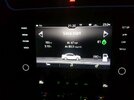So how does everyone find the calculated MPG and range in their cars these days?.
I've never been terribly impressed in the cars I've owned, or ones I've driven at work.
However, my new car (which I bought in December) seems pretty good.
I last filled up on 22nd May, and then went away for a few days to Chester (30 Mat - 1st June), so had a reasonable 'run' then. When I filled up I let the pump automatically stop, and then zeroed odometer A (it has two odometers, and I've got it set so this resets the average fuel consumption).
Then I ran it until going to work this morning when it was claiming a range of 26 miles, then the range changed to dashes and the low fuel light came on - I presume this means that the low fuel light is set at 25 miles?.
So coming back from work I called to fill up, at the same petrol station, at the same pump, on the same side - again, I filled until it auto-stopped.
It held 41.85 litres and I'd done exactly 410 miles, which works out to 44.5 MPG - which interestingly (and amazingly) was what the display in the car was showing as well. However, as the tank capacity is 47 litres, either there was more left than it seemed, or a full tank is more than the auto-stop point?.
So I'm quite pleased with the display accuracy
I've never been terribly impressed in the cars I've owned, or ones I've driven at work.
However, my new car (which I bought in December) seems pretty good.
I last filled up on 22nd May, and then went away for a few days to Chester (30 Mat - 1st June), so had a reasonable 'run' then. When I filled up I let the pump automatically stop, and then zeroed odometer A (it has two odometers, and I've got it set so this resets the average fuel consumption).
Then I ran it until going to work this morning when it was claiming a range of 26 miles, then the range changed to dashes and the low fuel light came on - I presume this means that the low fuel light is set at 25 miles?.
So coming back from work I called to fill up, at the same petrol station, at the same pump, on the same side - again, I filled until it auto-stopped.
It held 41.85 litres and I'd done exactly 410 miles, which works out to 44.5 MPG - which interestingly (and amazingly) was what the display in the car was showing as well. However, as the tank capacity is 47 litres, either there was more left than it seemed, or a full tank is more than the auto-stop point?.
So I'm quite pleased with the display accuracy



